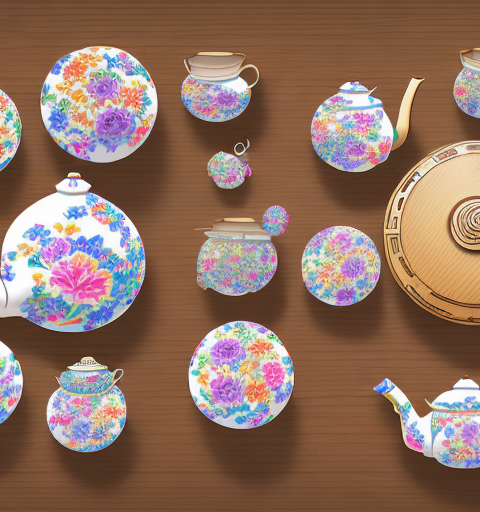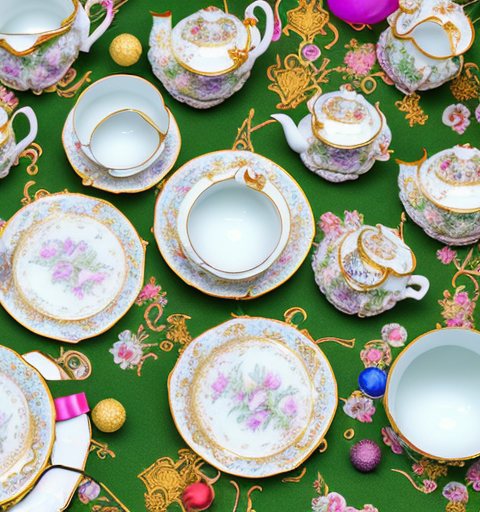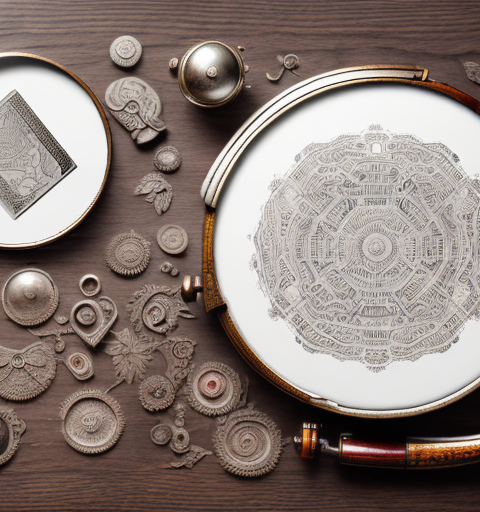Ceramic teapots have been a beloved choice for tea enthusiasts for centuries. Their classic appeal and ability to retain heat make them a popular choice for brewing and serving tea. However, one concern that often arises is their susceptibility to cracking. In this article, we will explore the durability of ceramic teapots, the common causes of cracks, the impact of temperature changes, manufacturing techniques, proper care and maintenance, signs of potential cracks, suitable brewing methods, alternative materials, factors to consider when purchasing, repairing and preventing further damage, expert tips for extending lifespan, comparing different types of ceramics, differences between glazed and unglazed teapots, and preventing sudden temperature changes. Let’s dive in!
Understanding the durability of ceramic teapots
Ceramic teapots, in general, are durable vessels that can withstand the rigors of daily tea brewing. When properly made and cared for, they can last for years. However, like any other material, they are not indestructible and can be prone to cracking under certain circumstances. These circumstances may include mishandling, temperature changes, or manufacturing flaws.
It is important to note that the durability of ceramic teapots can also be influenced by the type of clay used in their construction. Different types of clay have varying levels of strength and resistance to cracking. For example, porcelain teapots are known for their high durability and ability to retain heat, making them a popular choice among tea enthusiasts. On the other hand, earthenware teapots may be more susceptible to cracking due to their lower firing temperature and porous nature.
Exploring common causes of ceramic teapot cracks
Cracks in ceramic teapots can occur due to various reasons. One common cause is thermal shock, which happens when there is a sudden and extreme change in temperature. For example, pouring boiling water into a cold teapot can cause the walls to expand rapidly, leading to cracks. Other causes may include physical impact, improper storage, or inherent weaknesses in the ceramic material. By understanding these causes, tea enthusiasts can take preventive measures to minimize the risk of cracks.
Another potential cause of ceramic teapot cracks is improper handling during cleaning. Harsh scrubbing with abrasive materials or using sharp objects to remove stubborn stains can weaken the ceramic surface and create small cracks that can eventually lead to larger ones. It is important to use gentle cleaning methods, such as using a soft sponge or cloth, and mild dish soap to preserve the integrity of the teapot.
The impact of temperature changes on ceramic teapot integrity
Temperature changes play a significant role in teapot cracks. As mentioned earlier, the sudden change between hot and cold can cause stress on the teapot material and result in cracks. It is important to gradually adjust the temperature to avoid subjecting the teapot to extreme stress. Preheating the teapot with warm water before pouring boiling water can help reduce the risk of thermal shock and maintain the integrity of the ceramic.
Another factor that can affect the integrity of a ceramic teapot is the rate of temperature change. Rapid temperature changes, such as pouring hot water into a cold teapot or placing a hot teapot on a cold surface, can cause thermal stress and increase the likelihood of cracks. To minimize this risk, it is recommended to allow the teapot to cool down gradually or to use a teapot cozy to insulate it from sudden temperature changes.
In addition to temperature changes, the quality of the ceramic material used in the teapot can also impact its integrity. High-quality ceramics are typically more resistant to thermal shock and less prone to cracking. When purchasing a ceramic teapot, it is important to consider the material and choose one that is made from durable and well-fired ceramic. Taking proper care of the teapot, such as avoiding sudden temperature changes and using gentle cleaning methods, can also help prolong its lifespan and maintain its integrity.
Examining the role of manufacturing techniques in teapot cracking
The manufacturing techniques used in creating ceramic teapots can greatly affect their durability. Factors such as the quality of the clay, firing temperature, glazing process, and the craftsmanship of the artisans all contribute to the teapot’s resilience. High-quality teapots are typically made with attention to detail, ensuring even thickness and proper reinforcement in areas prone to stress, such as the handle and spout. Understanding the manufacturing process can help consumers make informed choices when purchasing a teapot and reduce the risk of cracks.
One important aspect of manufacturing techniques that can impact teapot durability is the quality of the clay used. Teapots made with high-quality clay are less likely to develop cracks, as the clay has better structural integrity and is less prone to shrinkage during the firing process. Additionally, the composition of the clay can affect the teapot’s ability to withstand thermal shock, which is important for teapots used for brewing hot beverages.
Another factor to consider is the firing temperature. Teapots that are fired at higher temperatures tend to be more durable, as the higher heat allows for better vitrification of the clay particles. This results in a denser and stronger teapot that is less susceptible to cracking. However, it is important for artisans to find the right balance, as firing at excessively high temperatures can also lead to brittleness and potential cracking.
How to properly care for and maintain your ceramic teapot
To maintain the longevity of your ceramic teapot, proper care and maintenance are crucial. After each use, it is recommended to rinse the teapot with warm water and gently clean it using a soft sponge. Avoid using abrasive materials or harsh chemicals that could damage the glaze or weaken the material. It is also important to store the teapot in a safe and dry place away from direct sunlight to prevent any possible discoloration or structural damage. By following these simple care instructions, you can help prevent cracks and enjoy your teapot for years to come.
In addition to regular cleaning and storage, it is important to handle your ceramic teapot with care. Avoid placing it on hard surfaces or subjecting it to sudden temperature changes, as this can cause the teapot to crack. When pouring hot liquids, use a tea cozy or handle cover to protect your hands from the heat. If you notice any chips or cracks in the teapot, it is best to stop using it and seek professional repair to prevent further damage. Taking these extra precautions will ensure that your ceramic teapot remains in excellent condition for a long time.
Identifying signs of potential cracks in a ceramic teapot
Spotting potential cracks in a ceramic teapot is essential to address the issue before it worsens. Look for visible cracks or lines on the surface, particularly around the spout, handle, or body of the teapot. Pay attention to any unusual sounds or vibrations when tapping the teapot lightly, as these may indicate existing cracks or weak points. By regularly inspecting your teapot, you can detect early signs of damage and take appropriate measures to prevent further cracks.
Another way to identify potential cracks in a ceramic teapot is to examine the glaze. Cracks in the glaze can be an indication of underlying cracks in the ceramic. Look for any areas where the glaze appears to be chipped, cracked, or uneven. These imperfections can be a sign of structural weakness in the teapot.
In addition to visual inspection, you can also perform a water test to check for cracks. Fill the teapot with water and let it sit for a few minutes. Then, carefully pour out the water and examine the interior of the teapot. If there are any cracks, you may notice water seeping through or pooling in certain areas. This test can help you identify hidden cracks that may not be visible to the naked eye.
The importance of using the right brewing methods for ceramic teapots
Using the right brewing methods can significantly impact the lifespan of your ceramic teapot. When preparing tea, avoid excessive force or straining the teapot by pouring the water gently. Additionally, make sure not to overheat the teapot by placing it directly on a stovetop or open flame. By using gentle brewing techniques and respecting the limitations of the teapot’s material, you can prevent unnecessary stress on the ceramic, reducing the likelihood of cracks.
Furthermore, it is important to clean your ceramic teapot properly after each use. Avoid using abrasive materials or harsh chemicals that can damage the surface of the teapot. Instead, use a soft sponge or cloth and mild dish soap to gently clean the teapot. Rinse it thoroughly with warm water to remove any soap residue. Proper cleaning not only helps maintain the appearance of the teapot but also ensures that no leftover tea or stains affect the flavor of future brews.
Exploring alternative materials for teapots to prevent cracking issues
If you are concerned about the potential for cracks in ceramic teapots, it may be worth considering alternative materials. Some options to explore include glass teapots, which are known for their transparency and heat-resistant properties, or cast iron teapots, renowned for their durability and heat retention. Each material offers unique benefits and drawbacks, so it is essential to consider your specific needs and preferences before making a decision.
In addition to glass and cast iron teapots, another alternative material to consider is stainless steel. Stainless steel teapots are highly durable and resistant to cracks, making them a popular choice for tea enthusiasts. They also have excellent heat retention properties, ensuring that your tea stays hot for longer periods. However, stainless steel teapots may not offer the same aesthetic appeal as ceramic, glass, or cast iron options. Ultimately, the choice of material will depend on your personal preferences and priorities.
Factors to consider when purchasing a ceramic teapot to avoid cracks
When purchasing a ceramic teapot, there are several factors worth considering to minimize the risk of cracks. Look for teapots made from high-quality ceramics that have been properly fired and vitrified. Check for even thickness across the walls, especially in vulnerable areas like the handle and spout. Research the manufacturer’s reputation, craftsmanship, and customer reviews to ensure they produce reliable teapots. Finally, consider the teapot’s design and shape, as certain designs or shapes may be more prone to cracks due to stress concentration points.
Another important factor to consider when purchasing a ceramic teapot is the glaze. A well-applied and durable glaze can help protect the teapot from cracks and chips. Look for teapots with a thick and smooth glaze that covers the entire surface, including the inside. Avoid teapots with glaze that appears thin, uneven, or has visible imperfections, as these may indicate a lower quality glaze that is more prone to cracking. Additionally, consider choosing a teapot with a glaze color that matches your personal preference and complements your kitchen or dining area.
Repairing and preventing further damage on cracked ceramic teapots
If your ceramic teapot develops a crack, immediate action can prevent further damage and potentially salvage the teapot. Repair methods vary depending on the severity of the crack, but options may include using food-safe adhesives specifically designed for ceramics or seeking professional assistance from artisans skilled in teapot restoration. It is important to act promptly to prevent the crack from spreading and compromising the teapot’s structural integrity.
Additionally, it is recommended to avoid using the cracked teapot for boiling or steeping hot liquids, as the heat can further weaken the ceramic and exacerbate the crack. Instead, consider using the teapot for decorative purposes or as a planter for small plants. This way, you can still enjoy its aesthetic appeal while minimizing the risk of further damage.
Expert tips for extending the lifespan of your ceramic teapot
To maximize the lifespan of your ceramic teapot, consider implementing these expert tips:
- Avoid exposing the teapot to extreme temperature changes.
- Handle the teapot with care, avoiding unnecessary impacts or drops.
- Follow proper cleaning and maintenance practices.
- Store the teapot in a safe and suitable environment.
- Use gentle brewing techniques and avoid excessive force.
By incorporating these habits into your tea brewing routine, you can extend the lifespan of your ceramic teapot and enjoy many delightful tea moments.
Additionally, it is important to note that using a teapot cozy or tea cozy can also help to extend the lifespan of your ceramic teapot. A teapot cozy is a fabric cover that fits snugly around the teapot, providing insulation and keeping the tea hot for longer periods of time. By using a teapot cozy, you can reduce the need to reheat the tea, which can help to prevent thermal shock and potential damage to the teapot.
Comparing different types of ceramics and their resistance to cracking
There are various types of ceramics used in teapot production, and their resistance to cracking can vary. Porcelain, for example, is known for its delicate nature and may be more susceptible to cracking than stoneware or earthenware. Bone china, on the other hand, is renowned for its strength and durability. Additionally, different glazing techniques and firing temperatures can also enhance a teapot’s resistance to cracks. It is important to research and understand the properties of different ceramics to make an informed decision when selecting a teapot.
Understanding the differences between glazed and unglazed ceramic teapots in terms of cracking susceptibility
The glazing process plays a crucial role in the durability of ceramic teapots. Glazed teapots have a protective coating that seals the surface and makes them less porous, reducing the risk of cracks. On the other hand, unglazed teapots may be more vulnerable to cracks as they lack this protection. It is worth noting that glaze quality and thickness can vary, so it is essential to choose well-glazed teapots from reputable manufacturers for optimal crack resistance.
Investigating whether certain shapes or designs make ceramic teapots more prone to cracking
While ceramic teapots come in various appealing shapes and designs, some may be more prone to cracking than others. Teapots with thin spouts or delicate handles may be susceptible to stress concentration points, increasing the likelihood of cracks. Similarly, complex or intricate designs with abrupt transitions in thickness can create weak areas prone to cracking. It is advisable to consider simpler and sturdier designs, with a focus on functionality and durability, to minimize the risk of cracks.
How to prevent sudden temperature changes that may lead to cracks in your ceramic teapot
To prevent sudden temperature changes that can cause cracks in your ceramic teapot, it is important to employ a few preventive measures. Gradually preheat the teapot by rinsing it with warm water before adding hot water. Similarly, when finishing your tea session, allow the teapot to cool naturally before cleaning or exposing it to cold water. These precautions will minimize the stress on the ceramic, reducing the risk of cracks caused by rapid temperature changes.
In conclusion, ceramic teapots can be prone to cracking under certain circumstances. Factors such as thermal shock, improper handling, inherent weaknesses, or manufacturing flaws can all contribute to teapot cracks. However, with proper care, appropriate brewing techniques, and understanding the intricacies of different ceramics, it is possible to minimize the risk of cracks and extend the lifespan of your ceramic teapot. By implementing these tips and being mindful of potential stressors, tea enthusiasts can continue to enjoy brewing and serving tea in their cherished ceramic teapots for years to come.






